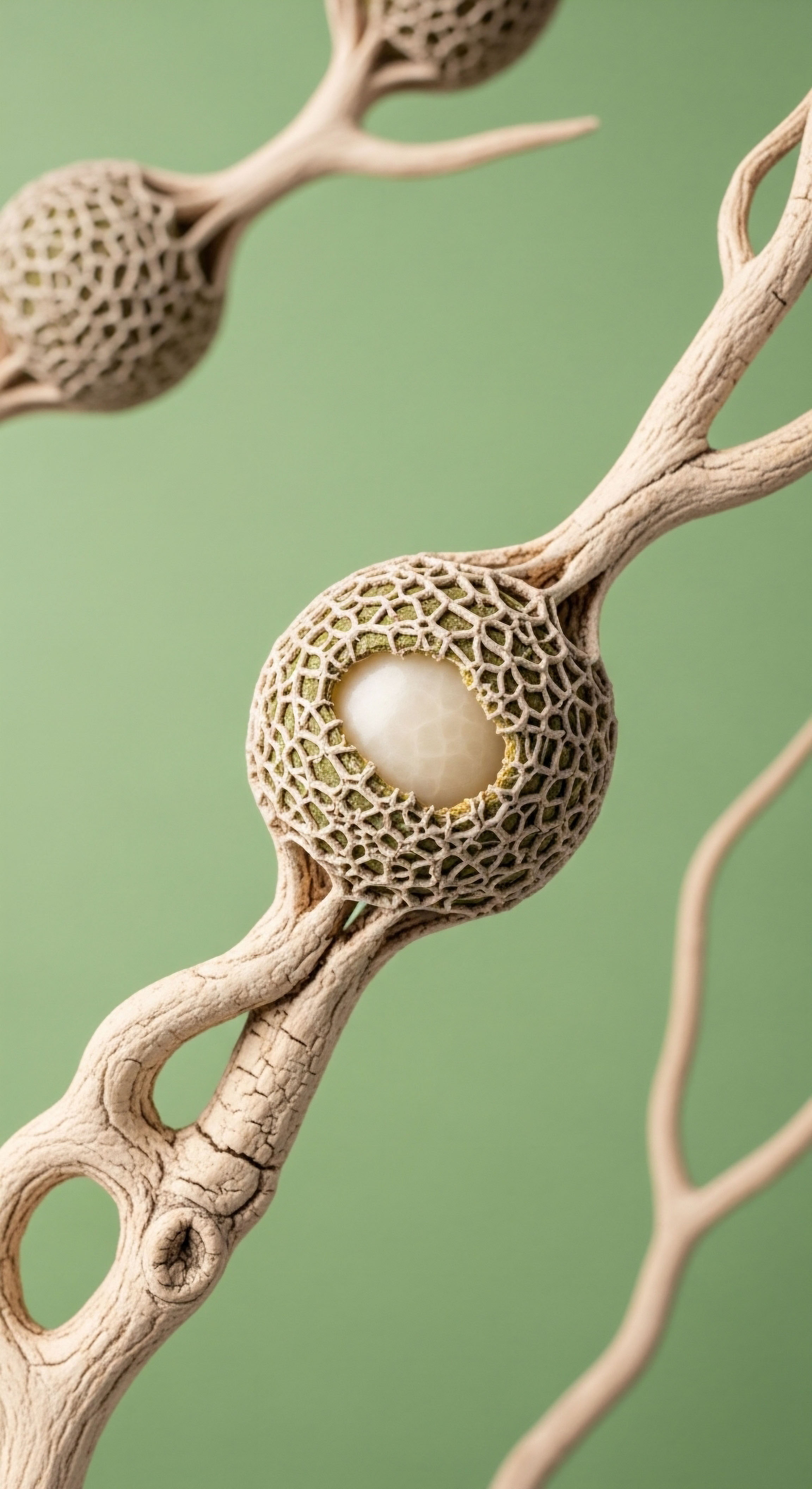

Fundamentals
Many individuals experience a subtle, yet persistent, shift in their overall vitality as the years progress. This often manifests as a quiet erosion of the energy once taken for granted, a diminishing drive, or a sense that the body simply isn’t responding as it once did.
Perhaps you find yourself grappling with a persistent fatigue that sleep cannot resolve, or a noticeable decline in physical strength and endurance. These feelings are not merely signs of aging; they frequently signal a deeper biological recalibration within the endocrine system, particularly concerning the foundational male hormone, testosterone.
Understanding your body’s internal messaging service, the endocrine system, is the first step toward reclaiming optimal function. Hormones act as chemical messengers, orchestrating countless processes from metabolism and mood to muscle maintenance and cognitive sharpness. When these messengers are out of balance, the symphony of bodily functions can become discordant, leading to a range of symptoms that impact daily life.
Recognizing these shifts within your own biological landscape is a powerful act of self-awareness, providing the initial data points for a path toward restoration.
A decline in vitality often signals a deeper biological recalibration within the endocrine system, particularly concerning testosterone.

The Endocrine System’s Role in Male Health
The male endocrine system is a complex network of glands that produce and release hormones directly into the bloodstream. Key players include the hypothalamus, the pituitary gland, and the testes, forming what is known as the Hypothalamic-Pituitary-Gonadal (HPG) axis).
This axis operates like a sophisticated thermostat, constantly monitoring and adjusting hormone levels to maintain a delicate equilibrium. When testosterone levels drop below an optimal range, this feedback loop can become disrupted, leading to a cascade of effects throughout the body.
Testosterone, while primarily associated with male characteristics, plays a far broader role in systemic health. It influences bone density, red blood cell production, fat distribution, muscle mass, and even cognitive functions like memory and spatial ability. A reduction in this vital hormone can therefore manifest in diverse ways, affecting not only physical attributes but also mental clarity and emotional well-being. Identifying these connections within your own experience is paramount to addressing the root cause of discomfort.

What Does Low Testosterone Feel Like?
The subjective experience of low testosterone, or hypogonadism, varies among individuals, yet common threads often emerge. Many report a noticeable decrease in libido and sexual function, which can be distressing. Beyond the bedroom, a pervasive lack of energy, difficulty concentrating, and a general sense of apathy frequently surface. Some men observe a reduction in muscle mass despite consistent exercise, alongside an increase in body fat, particularly around the abdomen.
Other symptoms can include irritability, mood fluctuations, and even symptoms resembling depression. Sleep disturbances, such as insomnia or restless sleep, are also commonly reported. These symptoms, while seemingly disparate, often point back to the central role of testosterone in maintaining physiological and psychological balance. Understanding that these experiences are valid and biologically rooted is the first step toward seeking appropriate guidance and potential solutions.


Intermediate
When symptoms of diminished vitality align with laboratory findings indicating suboptimal testosterone levels, a targeted intervention known as Testosterone Replacement Therapy (TRT) may be considered. This biochemical recalibration aims to restore physiological testosterone concentrations, thereby alleviating symptoms and improving overall well-being. The approach is not a one-size-fits-all solution; rather, it involves a precise, individualized protocol designed to mimic the body’s natural hormonal rhythms while mitigating potential side effects.
The objective of TRT extends beyond simply raising testosterone numbers. It seeks to optimize the entire endocrine environment, considering the intricate interplay of various hormones and their metabolic pathways. This comprehensive view ensures that the body’s systems are supported in a balanced manner, promoting a return to robust function. The therapeutic strategy involves carefully selected agents, each serving a specific purpose within the broader goal of hormonal equilibrium.

Understanding TRT Protocols for Men
A standard protocol for male hormonal optimization often involves weekly intramuscular injections of Testosterone Cypionate. This specific ester of testosterone provides a steady release of the hormone into the bloodstream, avoiding the sharp peaks and troughs associated with less frequent dosing. The typical concentration is 200mg/ml, with the precise dosage adjusted based on individual response and laboratory monitoring. This foundational element addresses the direct need for exogenous testosterone.
However, simply administering testosterone can have downstream effects, particularly on the body’s natural production and the conversion of testosterone into estrogen. To counteract these potential imbalances, additional medications are often integrated into the protocol. This multi-agent approach reflects a sophisticated understanding of endocrine physiology, aiming for a harmonious restoration rather than a simplistic elevation of a single hormone.
TRT protocols for men involve precise, individualized strategies to restore physiological testosterone levels and optimize the entire endocrine environment.

Supporting Natural Production and Managing Estrogen
To maintain the body’s intrinsic capacity for testosterone production and preserve fertility, Gonadorelin is frequently included. This peptide, administered via subcutaneous injections typically twice weekly, acts on the pituitary gland to stimulate the release of Luteinizing Hormone (LH) and Follicle-Stimulating Hormone (FSH). These gonadotropins, in turn, signal the testes to continue producing testosterone and sperm, preventing testicular atrophy that can occur with exogenous testosterone administration alone.
Another critical consideration is the conversion of testosterone into estrogen, a process mediated by the enzyme aromatase. While some estrogen is essential for male health, excessive levels can lead to undesirable effects such as gynecomastia (breast tissue development), water retention, and mood disturbances. To manage this conversion, an aromatase inhibitor like Anastrozole is often prescribed, typically as an oral tablet twice weekly. This agent helps maintain a healthy testosterone-to-estrogen ratio, ensuring a balanced hormonal profile.
In certain situations, particularly when supporting LH and FSH levels is a primary concern, Enclomiphene may be incorporated. This selective estrogen receptor modulator (SERM) works by blocking estrogen’s negative feedback on the hypothalamus and pituitary, thereby encouraging the natural release of gonadotropins. The inclusion of such agents underscores the nuanced approach to hormonal optimization, where the goal is to support the body’s inherent regulatory mechanisms.

Comparing Hormonal Optimization Agents
The selection of agents within a TRT protocol is highly individualized, reflecting the patient’s unique physiological responses and therapeutic goals. The table below provides a comparative overview of the primary medications used in male testosterone optimization protocols.
| Agent | Primary Mechanism of Action | Typical Administration | Primary Therapeutic Goal |
|---|---|---|---|
| Testosterone Cypionate | Exogenous testosterone replacement | Weekly intramuscular injection | Restore circulating testosterone levels |
| Gonadorelin | Stimulates LH and FSH release from pituitary | 2x/week subcutaneous injection | Maintain natural testosterone production, preserve fertility |
| Anastrozole | Aromatase enzyme inhibition | 2x/week oral tablet | Reduce estrogen conversion, manage estrogen levels |
| Enclomiphene | Selective estrogen receptor modulation | Oral tablet (variable frequency) | Support LH and FSH levels, potentially increase endogenous testosterone |
This tailored combination of agents aims to create a physiological environment that not only addresses the immediate deficit of testosterone but also supports the broader endocrine system, promoting long-term health and vitality.

What Are the Considerations for Post-TRT Protocols?
For men who have discontinued TRT or are actively trying to conceive, a specialized protocol is implemented to facilitate the recovery of natural testosterone production and fertility. This approach is distinct from ongoing TRT and focuses on stimulating the body’s own hormonal pathways.
- Gonadorelin ∞ Continues to stimulate LH and FSH, encouraging testicular function.
- Tamoxifen ∞ A selective estrogen receptor modulator (SERM) that blocks estrogen’s negative feedback on the pituitary, promoting gonadotropin release.
- Clomid (Clomiphene Citrate) ∞ Another SERM with a similar mechanism to Tamoxifen, often used to stimulate ovulation in women but also effective in men for increasing LH and FSH.
- Anastrozole (Optional) ∞ May be included to manage estrogen levels during the recovery phase, especially if there is a tendency for elevated estrogen.
These agents work synergistically to reactivate the HPG axis, guiding the body back to its endogenous hormonal production. The careful orchestration of these medications reflects a deep understanding of the feedback mechanisms governing male reproductive health.


Academic
The restoration of optimal male hormonal balance extends beyond the simple administration of exogenous testosterone; it requires a sophisticated understanding of the HPG axis and its intricate feedback mechanisms. The therapeutic objective is to recalibrate this central regulatory system, allowing for a more harmonious physiological state. This involves not only addressing the primary gonadal output but also modulating the upstream hypothalamic and pituitary signals, as well as managing downstream metabolic conversions.
The HPG axis functions as a classic negative feedback loop, akin to a finely tuned climate control system. The hypothalamus releases Gonadotropin-Releasing Hormone (GnRH), which signals the anterior pituitary to secrete LH and FSH. LH then stimulates the Leydig cells in the testes to produce testosterone, while FSH supports spermatogenesis in the Sertoli cells.
Circulating testosterone and estrogen then provide negative feedback to both the hypothalamus and pituitary, regulating GnRH, LH, and FSH release. When exogenous testosterone is introduced, this feedback mechanism can suppress endogenous GnRH and gonadotropin secretion, leading to testicular suppression.
Optimizing male hormonal balance requires a sophisticated understanding of the HPG axis and its intricate feedback mechanisms, extending beyond simple testosterone administration.

The Interplay of Hormonal Axes and Metabolic Pathways
The impact of testosterone extends far beyond its direct androgenic effects, influencing numerous metabolic pathways and interacting with other endocrine axes. For instance, testosterone plays a significant role in glucose metabolism and insulin sensitivity. Low testosterone levels are frequently correlated with increased insulin resistance, visceral adiposity, and a higher prevalence of metabolic syndrome. This connection highlights the systemic nature of hormonal health, where a deficit in one area can ripple through seemingly unrelated physiological processes.
Furthermore, the relationship between testosterone and inflammatory markers is increasingly recognized. Chronic low-grade inflammation can suppress testosterone production, while restoring testosterone levels may exert anti-inflammatory effects. This bidirectional relationship underscores the importance of a holistic approach to male health, where addressing hormonal imbalances can positively influence systemic inflammation and metabolic function. The body’s systems are not isolated; they are an interconnected network, and optimizing one component often yields benefits across the entire biological landscape.

How Do Neurotransmitters Influence Hormonal Regulation?
The central nervous system plays a pivotal role in regulating the HPG axis, with various neurotransmitters influencing GnRH pulsatility. Dopamine, norepinephrine, and serotonin, for example, all modulate hypothalamic GnRH release. Dopamine generally stimulates GnRH, while serotonin can have inhibitory effects. This neuroendocrine interface explains why mood disorders and chronic stress can profoundly impact hormonal balance, often contributing to or exacerbating symptoms of hypogonadism.
Consider the impact of chronic stress, which activates the Hypothalamic-Pituitary-Adrenal (HPA) axis, leading to elevated cortisol levels. Cortisol can directly inhibit GnRH and LH secretion, thereby suppressing testosterone production. This intricate cross-talk between the HPA and HPG axes illustrates how psychological stressors can translate into physiological hormonal dysregulation. A comprehensive approach to hormonal optimization must therefore consider the neuroendocrine environment and strategies to mitigate chronic stress.

Clinical Data on TRT Outcomes
Clinical trials and observational studies consistently demonstrate the efficacy of TRT in alleviating symptoms associated with hypogonadism. Improvements are often reported in various domains, including sexual function, mood, energy levels, and body composition.
| Outcome Measure | Observed Effect with TRT | Relevant Mechanism |
|---|---|---|
| Libido and Sexual Function | Significant improvement in desire and erectile function | Direct androgen receptor activation in neural pathways and vascular tissue |
| Mood and Cognition | Reduction in depressive symptoms, improved cognitive function | Testosterone’s influence on neurotransmitter systems and neuronal health |
| Body Composition | Increase in lean muscle mass, decrease in fat mass | Enhanced protein synthesis, lipolysis, and metabolic rate |
| Bone Mineral Density | Increased bone density, reduced fracture risk | Direct effect on osteoblasts and osteoclasts, estrogen conversion |
The data supports a multifaceted benefit, extending beyond symptomatic relief to include improvements in metabolic health and bone integrity. The long-term safety and efficacy of TRT continue to be areas of active research, with ongoing studies refining our understanding of optimal protocols and patient selection. The goal remains to restore physiological balance, allowing individuals to experience a return to their full potential.

References
- Morgentaler, Abraham. “Testosterone and the Prostate ∞ An Update.” Current Opinion in Urology, vol. 26, no. 2, 2016, pp. 143-148.
- Zarrouf, Fadi A. and John E. Traish. “Testosterone and Depression ∞ Systematic Review and Meta-Analysis.” Journal of Clinical Endocrinology & Metabolism, vol. 91, no. 10, 2006, pp. 3843-3849.
- Snyder, Peter J. et al. “Effects of Testosterone Treatment in Older Men.” New England Journal of Medicine, vol. 371, no. 11, 2014, pp. 1014-1024.
- Wang, Christina, et al. “Testosterone Replacement Therapy Improves Bone Mineral Density in Hypogonadal Men ∞ A Systematic Review and Meta-Analysis.” Journal of Andrology, vol. 33, no. 1, 2012, pp. 1-12.
- Bhasin, Shalender, et al. “Testosterone Therapy in Men With Hypogonadism ∞ An Endocrine Society Clinical Practice Guideline.” Journal of Clinical Endocrinology & Metabolism, vol. 103, no. 5, 2018, pp. 1715-1744.
- Boron, Walter F. and Emile L. Boulpaep. Medical Physiology. 3rd ed. Elsevier, 2017.
- Guyton, Arthur C. and John E. Hall. Textbook of Medical Physiology. 13th ed. Elsevier, 2016.

Reflection
The journey toward understanding your own biological systems is a deeply personal one, marked by self-discovery and the pursuit of optimal function. The knowledge shared here serves as a starting point, a framework for comprehending the intricate mechanisms that govern your vitality. It is a call to introspection, to truly listen to the signals your body sends, and to recognize that your lived experience holds profound biological meaning.
This information is not a prescription, but rather an invitation to consider the possibilities for recalibrating your unique physiology. Your path to reclaiming robust health is singular, requiring a personalized dialogue with qualified professionals who can translate complex clinical science into actionable strategies tailored to your specific needs and aspirations. The power to restore your inherent balance resides within a deeper understanding of your own internal landscape.



